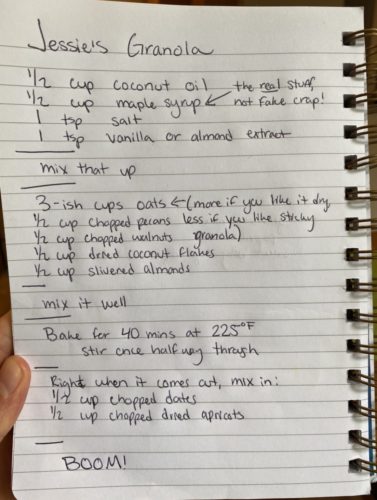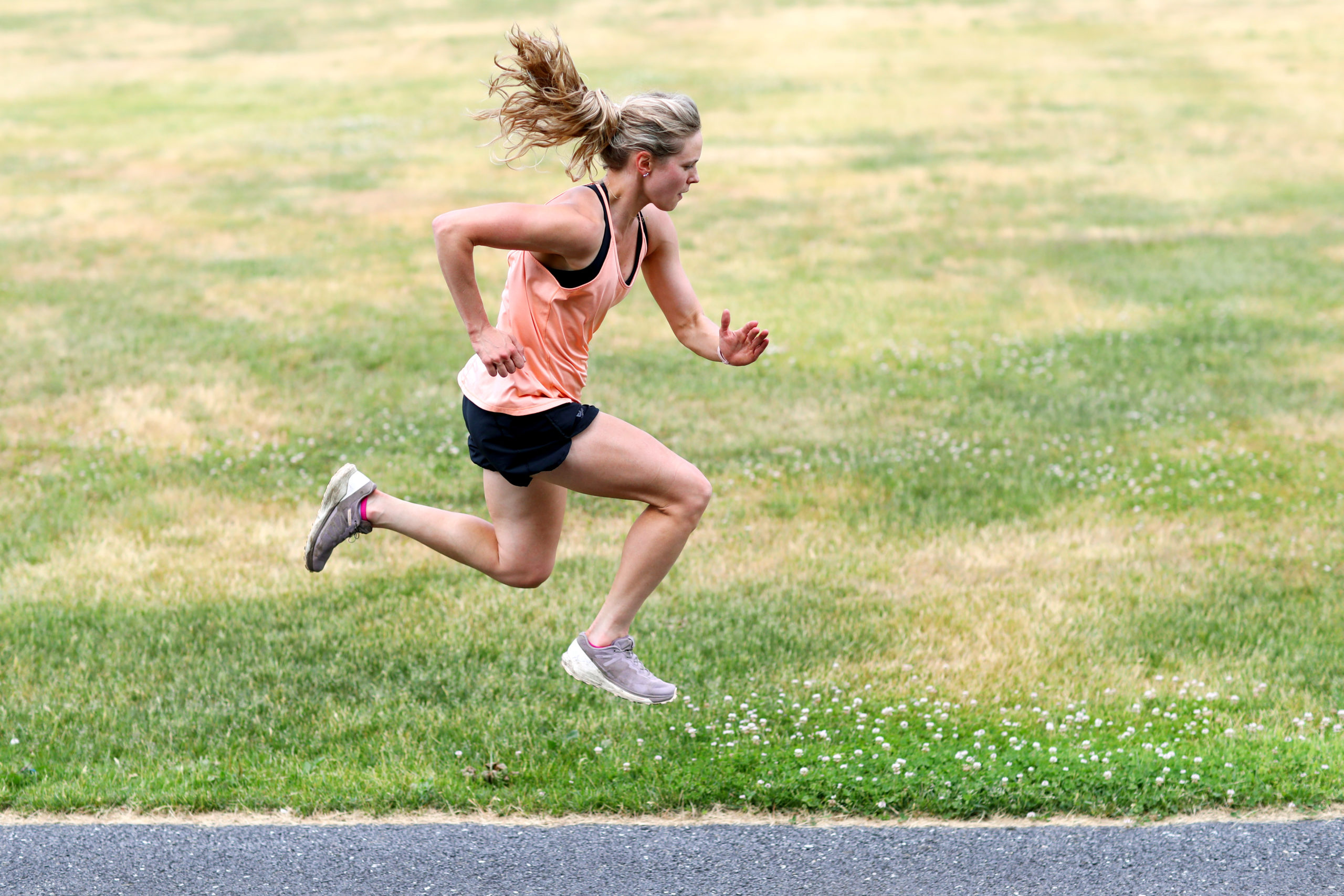All right, all right, Jessie…you’ve waxed poetic on how important it is to take care of yourself, to put health first, and to create a safe and supportive training environment. All good things! But what does that actually look like when it comes to putting food on your plate and eating before a race?
I’m so glad you asked.
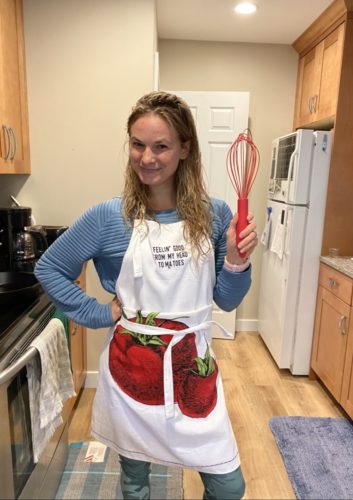
In part 2 of the training fuel series, I’ll answer some Q&A about how, when and what I eat. Again, I’m not an expert, nor or a dietitian. Especially if you have any tricky food allergies or intolerances, it’s worth meeting with a dietitian to come up with a plan for how you’re going to get all the nutrients you need to power through your day. What I can give you here is examples from my own fueling, which has been shaped by many meetings with the wonderful experts I’ve been fortunate enough to work with throughout my life.
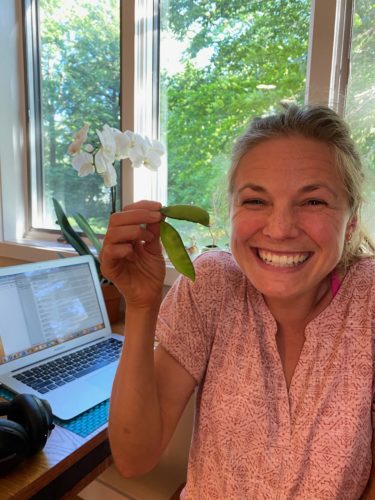
Fun fact: if you’re looking for someone to consult with, it’s important to find a registered dietitian, as they have to pass an exam, as opposed to a nutritionist. A registered dietitian is legally allowed to give clinical advice, and to be registered as a sports dietitian, they need to have two years working as an RD, sit an exam to become a sports dietitian, then retake the exam every five years. This is because what we know about sports nutrition is changing and evolving, and we want the experts we go to for advice to be up to date on current knowledge! One of many tools to find a dietitian near you to work with is this one, where you can search by zip code or by expertise. https://www.eatright.org/find-an-expert
In case you’re looking for more on this topic, my wonderful teammate and housemate Alayna Sonnesyn just put together a fun blog taking you through how we tackle hydration and eating during big hot summer training weeks. Complete with photos and links to recipes…you’re welcome! This is a fun and lighthearted way to see the variety of ways we fuel our training, so I’ll link it for you here: https://www.asonnesyn.com/blog/refuel-and-stay-cool
Now on to the Q&A!
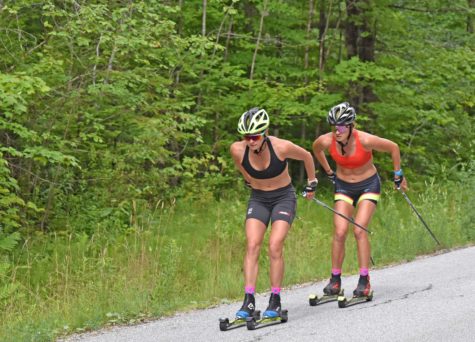
Question: How important is a post-workout snack/meal? Thoughts on the glycogen window?
I find this super important! Especially when I’m training twice a day, and want to be sure I can recover efficiently. Essentially, the idea behind the glycogen window is that right after a workout, your body is depleted and especially receptive to nutrients, so if you provide those within 30 minuets after training, your body will have the energy and nutrients it needs to recover faster. But the sooner you can get that food in, the better.
I like to imagine it this way: when I train, I’m actually breaking my body down. I’m knocking down the brick wall of my muscles, but that’s ok, because it’s going to be rebuilt taller and stronger than before! However, my body can only rebuild that wall if I give it the materials it needs. In this analogy, carbs are the bricks and protein and fat are the mortar. I need to make sure my body has all those materials right after I knock the wall down, because that’s when it’s ready to rebuild the fastest!
If I’m going for an easy 30 minute run, I’m not as worried about this, and I’ll be fine waiting until the next normal meal (unless I’m actually hungry, of course!) but after any training session longer than an hour, I make sure to have a snack that’s some mix of carbohydrates and protein ready when I’m done.
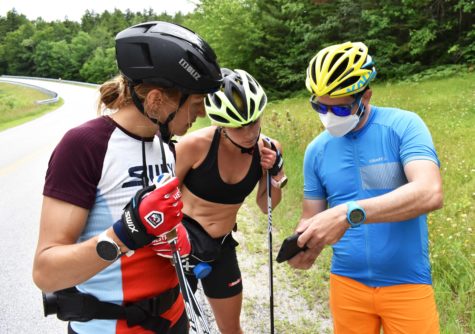
Some examples of post-workout snacks that have both carbs and protein:
- Virtually any sport nutrition bar (my go-to right now are Probar products, and I love the variety that they have available!)
- Banana and peanut butter, or a peanut-butter-honey-sandwich
- Fruit and yogurt
- Smoothie with frozen fruit, yogurt and either orange juice or almond milk
- Homemade muffin with oats, fruit and nuts
- Leftover pancakes/waffles/french toast with nut butter for protein
- Leftover pizza
- Granola with nuts and any type of milk
After a race, the same rules apply. My favorite way to accomplish this, since I’m usually not feeling particularly ready to snack right after a race, is to always have a shake ready at the finish. While I’m changing into dry clothes, before I head through the media zone and out for my cool down, I make sure I finish a Nutrimeal shake. I like this mix because it sits easy on my stomach, it has a nice blend of carbs, protein and fats, and I can easily get at least 300 calories in right after a hard race effort so my body can start that rebuilding process right away. I build it into my routine so I don’t have to think about it, but the idea of “eat, drink, dry clothes” as soon as possible after every race is one that can make your next race or training session more professional.
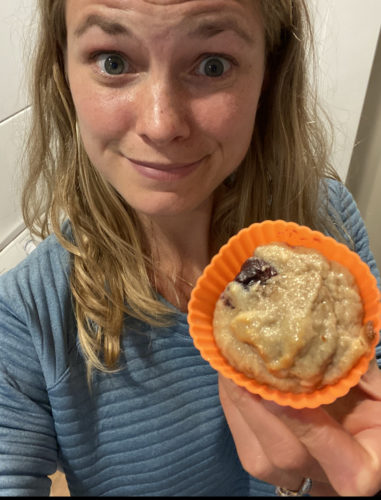
Question: Favorite pre-race/highest performance meal? What are some good options for food after/before practices and games?
Before training is when I try to be pretty conscious of what I’m eating…because I want to be sure it stays down when I’m working hard, and sits ok in my stomach! So if I’m going to be doing hard intensity training, I know my body will be needing more carbohydrates, and ones that I can digest easily so that energy is available.
Examples of what I eat before training in the morning when I have a little more time to digest:
- Most commonly, I have a bowl of oatmeal with berries, yogurt, honey and some nuts for breakfast.
- Smoothie bowl with all the creative toppings
- Pancakes with maple syrup and berries
- Toast with peanut butter, honey, banana and cinnamon
- Fried eggs on toast
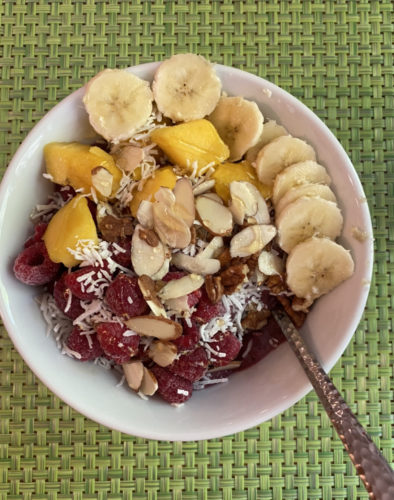
If it’s the snack before an afternoon workout, I try to make sure it’s mostly carbohydrates that I know my body can digest without issue. You wouldn’t want to eat a bag of green beans, for example, then go out for a run. But if you DO try that, don’t say I didn’t warn you.
Afternoon snack examples:
- Jam on a bagel
- Honey, cinnamon and salt on toast
- Banana bread
- Lucky charms mixed with popcorn. I see you rolling your eyes, and I’ll raise you two marshmallow unicorns. I stand by this as a really incredible snack! One, because it’s tasty. And two, because you’ll be needing that glycogen for the training ahead.
- Fruit popsicles. Especially if it’s hot and sunny outside, and I want to begin my workout with a cooler body temperature!
- Pretty much any kind of smoothie, but especially this one for a cold tasty dose of easily digestible carbs: 1 frozen banana, 1 cup almond milk, 1 T dark cocoa powder.
Before a race, I can usually eat a little more, because I start fueling a few hours out. I usually eat a big bowl of oatmeal with nut butter (peanut or almond or a blend of both!) berries or a banana, and maybe some yogurt and an egg on the side. If I’m eating this 3 hours before race time – since we usually race between 11-12 in the morning – I have enough time to digest this and then top off my glycogen stores with sport gummies (Probar Bolt strawberry is my jam) in the hour before the race while testing skis. I always have sport drink in my drink belt so I’m also making sure I’m sipping on electrolytes and easily digestible carbs right up until the race starts.
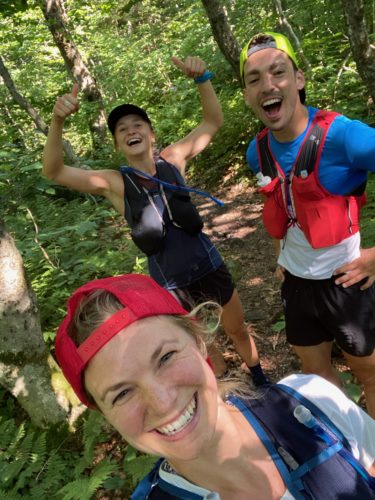
The best advice I’ve ever heard? Stick to what you know works with your stomach, and test this out (many times) in hard training sessions or time trials before! Even if you’re a die-hard oatmeal person, test out a backup plan in case your number one choice isn’t available at the hotel you’re staying at, or be sure to travel with the foods you know sit well in your stomach on race day.
During the Olympics, for example, I was your quintessential boring athlete that eats pretty much the same thing every day. Why? Because I was scared of upsetting my stomach, and I knew what worked for me on race day and kept me energized and fueled for hard efforts. I had checked in advance and knew there would be oatmeal, peanut butter and bananas available, and I traveled in with all the Probar products I would need for the Games. Normally, I try to be incredibly flexible with food, but the morning of your big day, it’s nice to stick to what you know your body accepts.
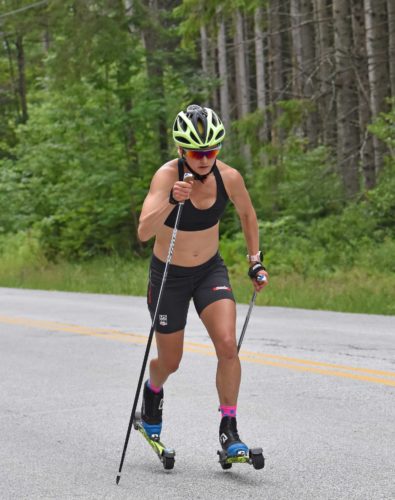
Question: Should you eat more on training days, or average it out through the week? And how do you look at fueling when curbing back on mileage, as this can be a mentally challenging thing for some?
In theory, I change the amount of carbs I’m eating to match the training so I can have enough energy that day, that workout, that hour. In practice, it likely averages out a little bit, because on really big days it’s hard to actually eat enough, so you need the days off to catch up. I don’t really change the amount of protein, fats, calcium sources and fruits/veggies I consume, but try to just up the carbohydrate intake on bigger training days. This is because as a cross country skier, my body is primarily relying on carbs as a fuel source.
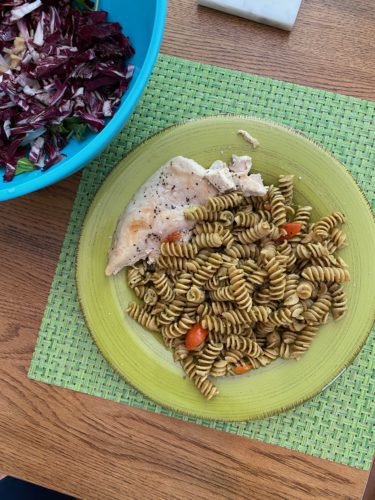
Trust that your body is going to ask you for what it needs if you listen to it. If I’m in a recovery week, my appetite naturally starts to decline as my body realizes I’m not placing as many high energy demands on it. That said, altitude and really hot weather can change your appetite, which is why it’s important to be sure you’re fueling and hydrating during longer or harder training sessions even when you’re not hungry or thirsty (more on this later in the blog, don’t worry!)
Think of a recovery day as a specific recovery plan – it’s important! Think of it as part of your mindset for getting ready for the next hard day. If I had a long run on Sunday, Monday is off and I know I have intervals and strength coming up on Tuesday, then even though I’m not training on Monday, I still need to be sure I’m fueling well and eating when I’m hungry! This is my day to catch up from the week, to be sure my energy stores are topped off, and to make sure I have the energy I need to start the next week of training in a great place. So if I’m hungry, I make sure to honor what my body is asking for by choosing some snacks.
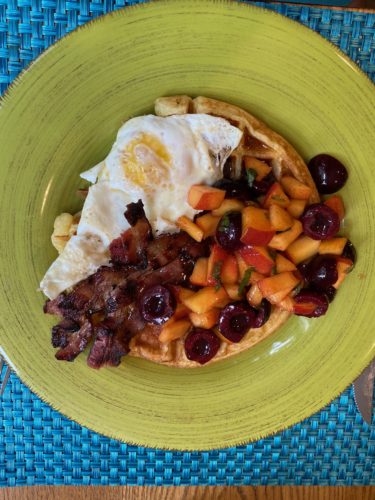
Question: How do you match your eating habits to your training level? And how does that change when you’re in season vs off season vs training?
This is a little bit similar to the question above, but I thought it deserved its own answer because of the second part of the question. I try to match my eating to my training level, for sure. That is, if I know I have a 4 hour training day, I’ll need to eat more and add in more carbs than a 2 hour training day. However, if I have a 2 hour training day that is high-intensity, then I need to be fueling with about as much carbs as the longer training day, because my body will need that fuel. It’s a mix of intensity and duration that dictates how much food I’ll need to consume to supply the energy I need.
In the off season, I don’t think about fueling much at all! And as a result, my body asks for less, because I’m expending less energy. I find that this happens organically; when I’m not training or racing, I’m not as hungry. I think this is a very common fear for athletes of any age or level; that when we stop training, we will not be able to stop consuming the amount of food we’re used to, and we will gain weight. I used to be very, very scared of this idea. But trust me when I say that when I stop training completely, as I do each spring, my body naturally adapts and I find that I’m just not as hungry as I am in full training season. I don’t gain weight, my body shape basically stays the same, and I still enjoy a wide variety of foods (and dessert!). It comes down to trusting that your body will ask you for what it needs, and being ready to really listen to your body.
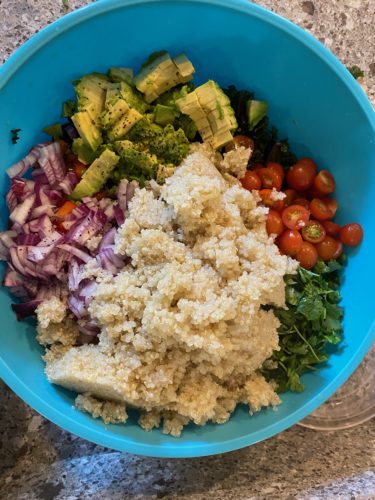
Question: How do I prevent overeating when I come home from training?
The first step is to make sure you fuel well during training. There actually is a lot of science behind this, involving consuming a certain amount of grams of carbs per kg of body weight per hour. If you want to get nerdy with it (in a good way), I highly recommend the book “Roar” by Stacy Sims and Selene Yeager.
The short answer? You should never be hungry when you’re racing or training. Would you let yourself be half-asleep during a big test? (the answer had better be NO, kids!). Would you try to drive a car without gas? Nope. So don’t short-change your workout by denying your body the fuel it needs.
During training fueling examples;
- I like to have gummies with me at all times; I usually just keep a package of them in my drink belt so I can have a quick hit of sugar when I need it mid-workout. This is the easiest way for me to keep my energy up as my body is burning through it’s glycogen stores.
- I like to have sport drink with carbohydrates in my water belt, always. However, sometimes I don’t like to put this in a camelback, because it’s hard to clean the tube and not let it get moldy! So on the occasions when I only have water, I make sure to also be eating gummies with that water, so I’m still getting the carbs and electrolytes I need.
- If my workout is 2 hours or longer, I also like to have a bar in my drink belt. I usually try to find a bar that is mostly carbs, because those are easier to digest than something with a ton of protein mid-workout.
- No bar? No problem. Take a piece of toast, smear some honey or jam on it, fold it in half and stick that thing in a ziplock baggie.
- Dried fruit or trail mix
My phone autocorrected “gummies” to “tummies” and “dummies” about 8 times while I was writing this blog, and I feel that this is important to mention, as the hungrier our tummies get, the dumber our decisions are, generally speaking.

Here’s where this gets tricky: you won’t always feel hungry during a workout, especially if you’re running or going hard. And now I contradict myself: I always try to listen to my body’s cues and honor them…but not in the middle of training. I always have snacks with me, and I make sure to eat them even if I’m not particularly excited about it.
And when you get home from the workout? Time for lunch, or dinner! The biggest thing here is don’t ignore your body’s cues; if it’s telling you you still still need food, it’s telling you that for a reason. Listen to what your body is craving, then make a choice to fuel, not a reaction. Fuel because your body is asking for it, not because you’re bored. But don’t ignore it when it’s asking.
For example, this morning I had bounding intervals up Stratton Mountain. I had Probar bolt gummies with me, and ate a few in the middle of the workout, and more once I had finished the intervals (but before the cool down). I had water in my drink vest, hence the extra gummies. When I got back to my condo, I made a fruit and yogurt smoothie, and then later when I was ready, I made lunch.
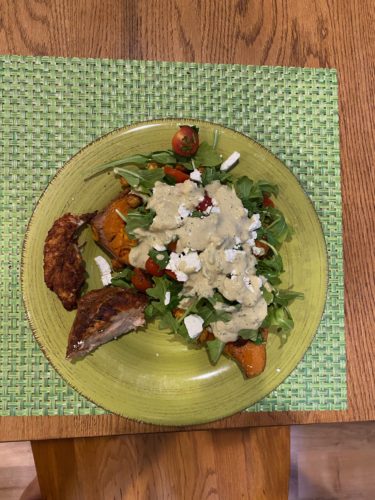
Question: How do I find out if foods are healthy and good fuel and not stress out if I want a treat? What is your view of eating sugar as an athlete?
In a nutshell, my view is this: sugar is tasty, and it’s ok to have a treat. Everything, in moderation, fits into a healthy fueling plan. Do I eat only cookies for dinner? No, but it’s fine if I have one (or two! Live a little!) after for dessert. At the 2018 Olympics I never had less than 4 Hershey’s kisses in my coat pocket. I don’t have any foods that I don’t eat because I’m worried they’re “bad” foods. Do I eat them every day? Probably not, but I also don’t eat carrots every day, either. I truly believe that if you can enjoy all types of foods in moderation, you never feel like you’re withholding anything from yourself, and you’re not tempted to go nuts on whatever food you’ve deemed “off-limits”.
Yes, there are complex carbs and there are processed sugars. But at the end of the day, as long as I’m getting a great mix of different foods and nutrients, my body isn’t going to give up and quit in the middle of a race if I’ve eaten white sugar. Sugar, by the way, is not always bad (in my view). Fruit has sugar. When I make bread, sugar helps activate the yeast. And all sport nutrition products have sugar in them for a reason; so your body can quickly absorb it and use it as fuel! Not all sugar is created equal, but there are different times when your body needs different types of fuel. In the middle of the day, I might choose more complex sources of carbs, like whole wheat bread and fruit. Right before a workout or race, however, I might choose simpler sources of carbs, like sport gummies or sport drink, so that I don’t have too much fiber messing with my stomach.
If you’d like a real-world example, here’s mine. For 7 years, the only World Cup sprint qualifier I’d ever won came after eating dense chocolate cake for breakfast. In the middle of Moscow, Russia, I decided it was the most appetizing option in front of me. My body needed that energy to stay warm in questionably cold racing temps, and it didn’t stop working because I’d eaten sugar. In fact, it thrived. Am I only going to eat cake for breakfast on sprint days? No. Will I keep an open mind and be flexible if my food option of choice isn’t there, and trust that my body can get it done even if conditions aren’t perfect? You betcha.
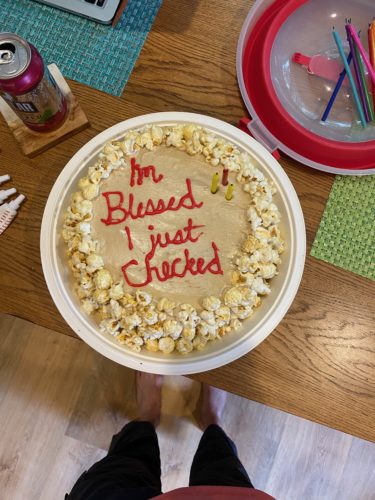
Question: How do you know how much food is enough without measuring/weighting everything or counting calories? I’m currently struggling with trying to eat “just enough” food that I can work out and feel energized, but I’m scared of eating too much because I think I have a tendency to eat bigger portions. But I also think that keeping track of what I eat could spiral into trying too hard to control what and how much I eat and avoiding certain foods.
I know this is a scary thing for many athletes (and non-athletes as well!), and it might be better answered in Part 1 of this blog series. However, I would say that you need to really listen to what your body is asking from you. If you’re eating during training, having a snack right after training and you’re still hungry…it might be that your body just needs more food. If you’re eating because you’re hungry and you feel like you’d be happy with most any snack, vs. craving a certain kind of food, chances are you just need to eat more. If you’re bored and want to have a bag of chips because you’re watching TV and not really hungry, that’s another thing to consider. But if you really are hungry, it’s important to eat. Personally, there aren’t any foods that I avoid (although I have mild lactose intolerance, so I go for the no-lactose options like oat milk or almond milk instead). I don’t worry about eating “just enough”, because if I’m listening to my body’s cues and training hard, my body will find it’s healthy spot where I can be energized, fast and injury and sickness free. Unless you’re working on a project with a dietician to figure out if you’re currently fueling enough, I wouldn’t keep track of what you eat, and certainly not for more than a few days. Because you’re correct, this can quickly spiral into some unhealthy habits for many people.
The other element to consider is that, while sport is a big part of your life…it’s still your life. And with many endurance sports, you’re in it for the long haul if you want to find your true potential. It’s important that you can be happy, not pedantic, about food.

Question: Are you ever hangry?
Hangry is that fun word used to describe the state of being when you’re so hungry that you get irrationally angry for pretty much no reason at all! It’s not a great spot to be in. Yikes! I try not to let myself get there by making sure I’m 1.) listening to my hunger cues and feeding my body when it asks me to with a variety of different meals and snacks and 2.) eating and hydrating during training sessions so that I’m not starving at the end. But yes, sometimes I get hangry, and I’m just not fun to be around when I haven’t packed enough snacks!

Question: Iron levels? Is this important for female athletes?
Yes, it is! You should get this checked – men, you too. Women are particularly prone to iron deficiency and it’s important to be sure your ferritin levels are in a healthy range (personally, I try to get mine above 50 by the start of the race season). This can be impacted by genetics, as well. For some reason, my body doesn’t like to absorb iron as well, even though I grew up eating red meat. So I take an iron supplement to be sure I’m getting enough.
Here are some other things that are incredibly important for not only female athletes but male ones too: How’s your skin? Your hair? Your nails? Your mood? If any of these are going downhill, it could be a sign that you’re not fueling enough.
This one’s for the girls, but it’s very important: you should get your period. Regularly. This becomes tricky depending on what birth control you may or may not be on, as some of them will make you get your period no matter what, while some will make you not get one even though you normally would. This can complicate using your cycle as a way of checking in with your overall health and energy availability. But all things being equal, it’s important that you get a regular period, as it’s a really important marker of your health. To be honest, REDS (relative energy deficiency syndrome) deserves it’s own blog post, and I won’t have enough room to really do it justice here. But this is something you should look up, ask your coach about, and be sure that as a female athlete you are taking good care of your long-term health.
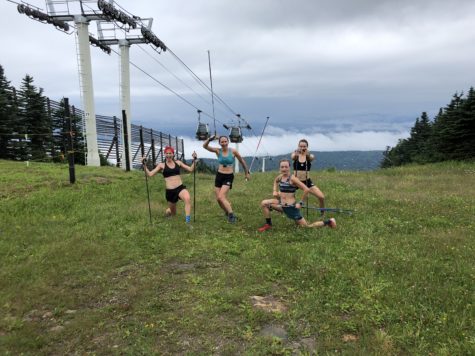
Question: How does this all shake out in a day of training? What are some examples of how you eat?
How do I build a plate at lunch or dinnertime? The attached photo (very, very scientific and photogenic, I might add) shows what I’m aiming for at lunch and dinner, when I know I have time to digest my food long before the next workout. I try to get a great mix of carbohydrates, fruits and veggies, a source of calcium (I don’t say dairy specifically because of the lactose intolerance), a source of fats, and protein. I’ve sprinkled photos of different meals we’ve cooked in the past few weeks to show how that might look on a plate – it can be fun and creative!
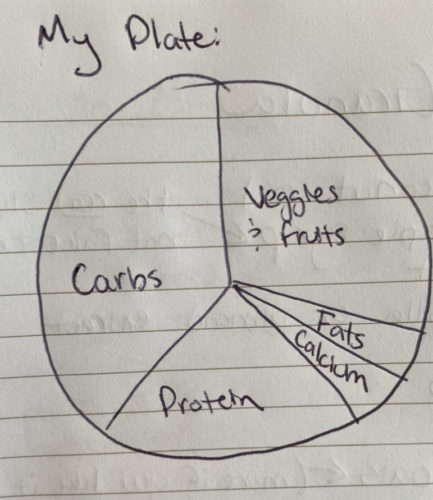
I DO eat fresh fruits and vegetables every day. I feel like the nutrients and vitamins I get from these keep me healthy and keep my immune system functioning at a higher level. Also, they’re another good source of complex carbohydrates!
Examples of a pretty standard lunch/dinner, if you’re looking for some meal inspiration:
- Shrimp linguine with roasted broccoli
- Burgers, corn on the cob and sweet potato fries
- Homemade pizza night
- Mixed veggies, feta cheese and quinoa in a salad with grilled chicken
- Brown rice risotto with ground beef, mushrooms, peas, parmesan cheese and lemons.
- Tofu and veggie stir fry scramble with peanut sauce and rice
- Salmon with sourdough bread and a side salad
- Chicken pesto pasta with cherry tomatoes and arugula lettuce
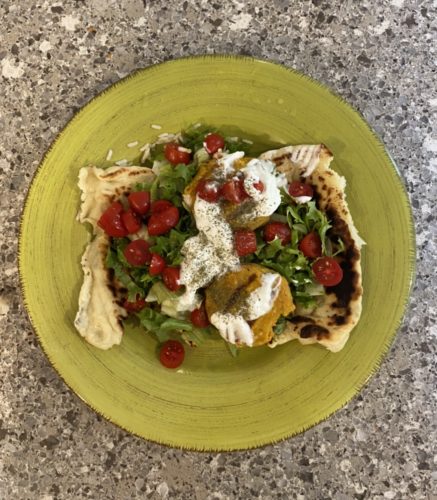
Please notice: none of these pre-workout or post-workout meals are exotic, particularly hard to make, or ridiculously picky. I will happily enjoy homemade cookies, waffles and leftover pizza after a workout, and I will also enjoy a Probar if that’s easier for me to carry during training. Yes, this is professional sport, but this is also life. It’s important to enjoy it. So my personal philosophy around fueling in sport is this:
- Eat when your body is telling you it’s hungry, and then honor that cue; don’t just eat because you’re bored, or suppress that hunger cue your body is telling you.
- Eat before and after workouts
- Eat a wide variety of meals and foods
- Eat dessert, too
The recurring theme here is to eat; and to enjoy it, not to stress over it. So invest in a good cookbook. I personally love the Run Fast Eat Slow by Shalane Flanagan and Elyse Kopecky, Dining In by Alison Roman and The Birchwood Cafe Cookbook. Invest in some time and energy finding meals that you truly enjoy and can appreciate with friends. Invest in over-the-top birthday cakes that bring people together. And invest in a kickass granola recipe that you stand by. If you’re short one, I will lend you mine. Happy training, and happy fueling!
